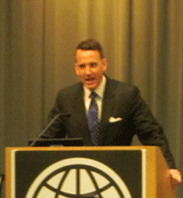
|
| Dr. Ed Glaeser speaking at the World Bank in Washington 10 March 2011. |
Dr. Glaeser discussed this and other themes raised in his new book Triumph of the City: How Our Greatest Invention Makes Us Richer, Smarter, Greener, Healthier and Happier at World Bank headquarters in Washington yesterday.
The presentation was part of the World Bank’s new Urbanisation Knowledge Platform, which promotes dialogue and exchange of ideas on urban issues.
In his remarks, Dr. Glaeser highlighted the critical role cities play as part of the development process: as centres of innovation, sources of productivity and agents of change (as exemplified by the pivotal role of Cairo in the recent Egyptian uprising).
He also highlighted several of the key messages of his book:
- Cities are people, not structures. Cities are fundamentally places that bring people together and enable them to learn from each other. This emphasis on people is especially important factor in urban regeneration; struggling cities with skilled populations have a much better chance of becoming successful once again. He cited the example of Detroit, whose long history as an innovative automotive centre created a low-skilled population reliant on a single industry, making it difficult for the city to grow and adapt, as New York City and Chicago did.
- Urban poverty is not a sign of a failed city. The fact that a city attracts people in search of opportunities is a sign the city is working, Dr. Glaeser suggested, expressing the view that the urban poor have better access to opportunities and services than those in rural areas. However, he also noted that we should not be complacent about urban poverty, and that it is critical to manage the “demons of density”, such as disease, congestion, and crime.
- Over-regulation of land use hinders growth. One of the downsides of urban success is affordability. Dr. Glaeser cited the example of Mumbai, whose rigid land regulation makes it very difficult to build any new construction and thus housing is unaffordable for many residents. Less restrictive regulations on new building allow cities to grow, such as by building up to accommodate growing populations.
- Cities are enormously green. Cities overall have much lower carbon emissions per capita than the suburbs. As Dr. Glaeser noted, “People don’t want to live like medieval serfs. If they end up living in a low-density area, they’ll drive a lot, and they’ll want big houses that are comfortably cooled and heated.”
At the event, expert panelists were invited to provide their perspective on Dr. Glaeser’s arguments.
Bruce Katz, a vice president at the Brookings Institution and founding Director of the Brookings Metropolitan Policy Program in Washington, suggested that it is important to think in terms of metropolitan areas, not city centres. He noted that suburbs are also places of innovation, such as California’s Silicon Valley, the birthplace of innovators such as Yahoo and Google. And in the United States, suburbs are also the drivers of political change.
Junaid Ahmad, Sector Manager for Urban and Water for the Africa Region at the World Bank, said that Dr. Glaeser’s way of thinking about urban has special relevance to development organisations such as the World Bank that are operating in an increasingly urbanised world.
“We have yet to understand the power of urban in development,” Dr. Ahmad said. It is important to think of urban as a development space rather than a sector and address it from an integrated perspective, he suggested. “Cities are constantly changing,” Dr. Ahmad said. “The question is, how do you enable that change?”
For More Information




